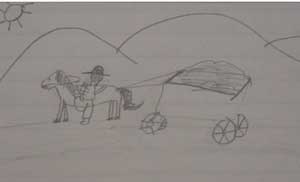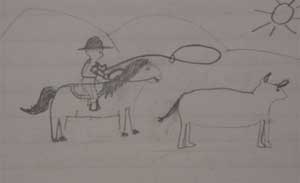
A rancher trting to get on his horse pulling an ox cart

Spanish Living by L. H.
Spanish explorers came to look for gold.
In 1542, Juan Cabrillo arrived in the Santa Maria Valley. The indians traded food for glass beads.
In 1787, Father Lasuen built La Purisima Concepcion Mission to change the Indians religion.
In 1776, Juan De Anza brought settlers from Mexico to San Francisco. They stayed near Orcutt.
Cattle Ranching:
Santa Maria Valley was too dry for cattle, but miners needed meat so the demand for cattle increased. The ranchers were managed by Spanish. Rancheros who (hires) used indiands to help with cattle roundups.
Buyers for cattle came from S.F. + L. A. Rancheros would round up several thousand cows for them. Payment was not always made in gold.
Most land owners
did not save their money. Conditions were harsh and many ranchers lost
cattle and land. Abraham Ontiveros built a reservoir to irrigate his land
to begin farming.
How people got around:
The horse and two-wheeled oxen carts were the main source of transportation. Most vaqueros were cruel to their horses. The men were usually hurt or died while making the wild horses tame.
Branding cattle was
the only way to tell how many cattle belonged to each ranch. There were
no fences.
Tally sticks:
Notches on a tally
stick were used as a way of counting cattle.
Reata:
Dried stretched cow hides were braided together to make rope.

A rancher trting to get on his horse pulling an ox cart
Resources
Third Grade Santa Maria Curriculum Binder